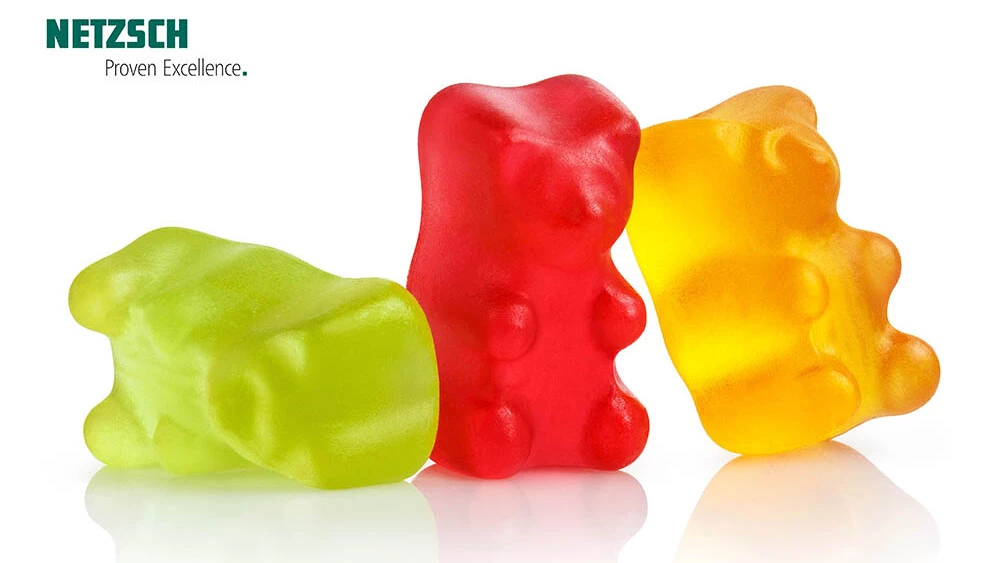
21.03.2022 by Aileen Sammler
Gummy Bears Under the Microscope
Fruit gummies are delicious and taste good throughout the year, be it in summer or winter, in the desert at 50°C or at the North Pole at -40°C. The goodies seem to exhibit a broad spectrum of elastic properties, varying between soft and hard and are strongly influenced by temperature. Dynamic-mechanical analysis is employed for the characterization of visco-elastic properties.
The ever-popular gummy bears celebrate their 100th birthday this year. Entrepreneur Hans Riegel invented the gummy bear in 1922 in Bonn, Germany. His company, Haribo, was the first to launch the so-called “dancing bear”, which has been called Goldbär since 1960, and is still the market leader today. The original “dancing bears” were not only larger than today’s gummy bears, but also softer, as gum arabic was used instead of gelatin in their production. Since then, many other manufacturers have also begun offering many varieties of gummy bears as well. (Source: wikipedia)
We are taking this anniversary as an opportunity to investigate the visco-elastic properties of this tasty snack with the help of our NETZSCH analysis instruments.
Fruit gummies are delicious and taste good throughout the year, be it in summer or winter, in the desert at 50°C or at the North Pole at -40°C. It would be unpleasant if these “sweet treats” were to stick together at high temperatures and form a sort of cohesive, sticky mass – or if a tooth were to fall by the wayside when biting on them in the cold. These examples make it clear that:
Fruit gummies seem to exhibit a broad spectrum of elastic properties, varying between soft and hard and are strongly influenced by temperature. Dynamic-mechanical analysis is employed for the characterization of visco-elastic properties. When coupled to a humidity chamber, influences of drying and humidification on their mechanical behavior can also be recorded.
Read our latest application note and learn more about:
- The mechanical behavior of fruit gummies from different climatic zones and continents
- The production of gelatin, its use and function in food products, and possible plant-based substitutes for vegan fruit gummies
- The measurement of dynamic-mechanical behavior at different temperatures and humidity levels using the NETZSCH DMA GABO Eplexor® connected to a Hygromator
- The differences in measurement results for gummy bears containing gelatin compared to vegan fruit gummies
- The influence of temperature changes on bite strength and flavor intensity
- Using dynamic mechanical analysis for the evaluation of consumer-relevant product properties of foods such as fruit gummies, thus serving for product improvement and new development as well as for the development of additional fruit gummy types, especially with new binders for vegan customers
Some results in advance: The vegan samples of fruit gums from Germany are firmer to the bite, while gelatin-containing samples taste more intense when melted. Australian and New Zealand vegan samples are offered in a market with high average outdoor temperatures, which places special demands on the dimensional stability and stickiness of the fruit gummies. So it is no surprise that the Oceanic products have the highest softening temperatures of all the fruit gummies studied, and that the cuboid samples in particular are relatively stiff up to the freezing point and have the highest E-moduli.
Download application note here!
Summary:
The NETZSCH DMA Eplexor® offers a routine procedure for the evaluation of consumer-relevant product properties of foods such as fruit gummies, thus serving for product improvement and new development.
The temperature dependencies of the E modulus (stiffness) and damping are closely related to the firmness-to-bite and melting behavior of the fruit gummies. Knowledge of the moisture dependencies, on the other hand, is of greater value for evaluating the storage conditions.
For the development of further fruit gummy types, especially with new binders for vegan customers, dynamic-mechanical analysis offers the capability to record both thermal and mechanical properties in the laboratory in advance, and thus to launch the products onto the market faster and in a more targeted manner. Furthermore, storage and processing conditions along with the parameters of moisture and temperature can be simulated by means of DMA measurements.
For more information, please visit our websiteor take a closer look at our product catalogue.
Sources: 1) Gummibär – Wikipedia